|
Your new documentary Heart
Attack! The Early Pulse Pounding Cinema of Kelly Hughes - well,
the title makes it pretty obvious what it's about, so what can you
tell us about your "early pulse pounding" movies?
In 1991 I started writing
and directing a weekly TV show in Seattle called Heart
Attack Theatre. I made thirty-three episodes. And this led to me
making the worldís first zombie drag queen movie, La
Cage aux Zombies. And then Twin
Cheeks, an experimental art film that borrows imagery from David
Lynchís Twin Peaks,
perverting what was already disturbing material. This early work also
includes a TV pilot about a self-destructive interior decorator with
multiple addictions called The
Bicci Show.
What
got you into making movies even, and how did Heart Attack Theatre
come into being?
I
wrote and directed my first plays in elementary school. And even back then
made guys play the female parts in drag. In the late Ď80s I graduated
from broadcasting school. But really didnít do anything movie-oriented
at first. My training there was mostly in radio announcing. And writing
news and commercials. Although we did learn how to splice and edit
reel-to-reel audio tape. And had access to some nice sound effects records
on vinyl.
By around 1989 or so, I felt the need to do something creative. So I entered
a playwrightís festival. And wrote and directed a musical called Lucky
Charm. It had a supernatural element involving a schoolhouse that
burned down a hundred years before. And the ghosts of the dead children
haunting the location. It had a few eerie effects. But the upbeat songs
gave it more of an Annie feel.
After
that, I wrote an actual operetta (no dialogue, everything was sung.) This
was after Phantom of the Opera
first opened on Broadway. And gothic musicals were all the rage. So I
wrote this musical called Paul
Bunyan: An American Tragedy. And gave it a supernatural, religious
fundamentalist twist. With Paul Bunyan being the target of a village
preacher who considered this large, lust-inducing man an abomination in
the eyes of God, and a threat to their community.
After
that I started making a movie called Trish
Must Kill. It was about the daughter of an archeologist. And when he
digs up an ancient necklace, he awakens an evil spirit that possesses his
daughter, making her kill. And her name was Trish.
During
this time I was teaching a drama class one night a week through the YMCA.
And had written a play for my students to perform called Flat Tire.
And performing it was basically their final exam. One of
my students, Mary, couldnít remember her lines. And spent most of the
first night of class on
the verge of a manic episode, threatening to leave, diverting all my
energy into persuading her to stay. But instead of inviting my more
accomplished students, I only asked Mary to be part of Trish
Must Kill. Perhaps I enjoyed the irony of casting her as the
psychiatrist?
I shot it all on a cheap home video camera. And other than Mary, all of the
other actors were my friends. And I made the story up as we went along.
Which is the last time I did that because all my projects are scripted.
And even though some of my stuff looks spontaneous, there is no
improvising in my projects. Thatís not the way I work. Iíve learned to
be more flexible. But I donít think itís fair to actors to expect them
to write your script for you. Or for them to wait around on set while
youíre still writing. And I like my words spoken the way I write them.
Even changing the order of a few words can change the effect Iím going
for. So I donít allow my actors to do that.
Then,
in September of 1990, I traveled across the USA, videotaping a cyclist
from Seattle to New York for a documentary. This gave me access to a new
and better camcorder and video deck. Panasonic Super-VHS equipment. It
seemed like Hi-Def compared to what Iíd been using. But still primitive
by todayís standards.
A
few months after the trip, I learned about Public Access TV. Which was
this cable channel that let you air your own show. For free, even. Because
the government made them. Which seemed like a big deal to me. Because this
was way before YouTube. And I thought only Hollywood produced material
could get on TV. So
I signed up for a show, not really knowing what it was going to be about.
I thought of the name Heart Attack
Theatre while riding the bus on the way to the station. And then
created a show that would live up to that name. Something lurid, trashy,
fun, and maybe even artistic.
I was a last minute replacement for a show that backed out. Which only gave
me a week to create my first episode. It was a half-hour show. Which is
actually a lot of time to fill. So that first episode pretty much set the
schedule I used for that first season. I would write the script on my
lunch hour on Friday (I worked full-time at another job while I did this.)
Shoot the scenes over the weekend. Edit Sunday night, and Monday and
Tuesday when I got home from work. Turn it into the studio Wednesday. And
then they would air it that Friday night. And I would already be starting
the whole process all over again. Making a new episode every week with no
room for delays. I had to create something whether or not I felt inspired.
Or else I would lose my valuable time slot at 10:00PM on Friday nights.
Failure and excuses were not an option. And I did it without a crew. I
operated the camera. And hoped that the built-in microphone would capture
everyoneís voice without too much background noise. What can you tell us about audience
reactions to Heart Attack Theatre back in the day?
I had no idea if anyone actually watched it. Public access had no Nielsen
ratings. At the time, I didnít even have cable TV myself. So I usually
didnít even watch it when it aired.
But after the first two seasons, I held an event at a local media arts center.
It was one of the few places in town that had a video projector. And I
screened a retrospective of my Heart
Attack Theatre work. And afterward, this guy in the audience
introduced himself. He said he was a fan. And that he taped each weekís
episode. I was flattered. But also worried thinking, ďIs this some
nut?Ē But he turned out to be Steven Shaviro, the Film Studies professor
at the University of Washington. And he had written a book called The
Cinematic Body (which the next day I bought and read). And in the
book, he studied Warhol, Fassbinder, Cronenberg and George Romero from a
scholarly perspective. And I thought, ďI donít know if anyone else
likes what I do. But if I could choose only one fan, none would be as
flattering as this guy.Ē And I was excited that an academic could look
past the campy low-budget trappings of Heart Attack Theatre. And appreciate some of the deeper effects I
was going for. To understand my references.
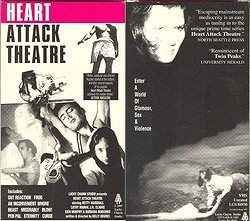 |
What
was a Heart Attack Theatre-shoot usually like?
Most
of my shoots were in and around my apartment. I had a large living room,
and minimal furniture. So I was constantly moving things around to make it
look like a different location from every angle. And we would shoot in the
boiler room in the basement. And on the roof. Which Iím surprised (and
grateful) no one fell off of.
But
I especially liked shooting outdoors. Or in public venues. And we would
just show up at places and start shooting. Stores, fast food restaurants,
libraries, churches. And weíd get everything in one take. Then leave
before people noticed us. Or called security. The only trouble we ever had
was at a public playground where some power-hungry office worker told us
we couldnít shoot there without permission. And we actually stopped and
listened to this guy for fifteen minutes. Ranting about how someone had
driven a motorcycle into their hallway without permission after they
agreed to let a film crew shoot a biker movie at their school. And this
guy equated our shoot (me, two actors, and a camcorder) with this big wild
biker movie production. But deep down I knew he was just jealous that we
were doing something cool.
One weird thing about our shoots was that people would always be leaving crap
in my apartment. Female actors especially would leave clothing, makeup,
hairspray, brushesóyou name it. So one day, I put all this crap on the
floor next to my front door. And every time someone would visit, I would
make them take items home when they left. I mean, there were four curling
irons. Not just one, but four. And I donít remember the women curling
their hair that often. I still donít know where they all came from.
Props, clothing, a toilet even. Although the toilet was from another play
I started working on. A women-in-prison story called Fever.
But I still canít remember who brought the toilet, or why
it was in my living room. Many
of the actors in these movies were pretty much regulars - so how did you
go about recruiting your cast?
|
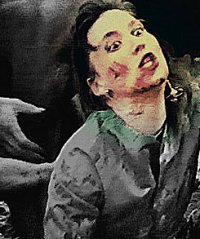
Cathy Roubal in
La Cage aux Zombies |
I
put a casting notice in the local paper. And auditioned people in my
apartment. Which sounds like something a pornographer would do. So I bent
over backwards to make people feel comfortable. Thank goodness the toilet
wasnít in my living room then. I
also used a couple actors who had been in my stage plays. And my friend
Cathy who had played Trish (and went on to star in
La Cage aux Zombies.) But for the most part, they were all strangers
at first.
I
used to joke that getting cast was easy. And that their first Heart
Attack Theatre episode was the actual audition. And that if I liked them, I would ask
them back to do a second episode.
One of the first people I auditioned was a middle-aged woman named Betty. At
the time she was selling real estate. Didnít have a lot of acting
experience. But I liked her personality, so I cast her. On the first day
of shooting, I had her fall off a boat into deep water. Then learned she
couldnít swim, and she almost drowned. But I loved that she would risk
her life to be on TV. So I kept casting her. And started writing roles
just for her. Even made her the ingťnue at times, pairing her with male
love interests half her age. And after Heart
Attack Theatre,
she played roles in most of my other video and stage work, including Fever.
What inspired you to make
a documentary about your Heart Attack Theatre-days roughly two
decades later?
I
got the idea after I started to digitize old episodes and put them on YouTube. And realized that, for this current generation, they would take
for granted what we did. I wanted to make a time capsule. To represent a
specific place in time. To show that in the early Ď90s, before everyone
had streaming videos, and the ability to become a YouTube star, that
public access allowed us to create unique programming. But that we had to
jump through a few more hoops. And make the most of our local audience and
circumstances. Make the most of our primitive equipment.
|
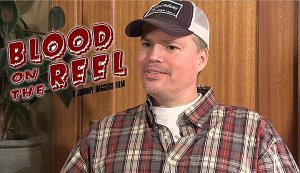
|
I also have this compulsion to say, ďHey, my work is important.Ē I may
not have received the same recognition as Twin
Peaks and Northern Exposure.
Or the intense awareness of the Seattle grunge bands during that time. But
I believe I deserve a place in Seattleís cultural history. I think I did
something unique. And Iím proud of my underground aesthetic. Impressed
that I was able to put out a body of work with virtually zero resources.
Happy that watching my work still makes me chuckle. Still makes me proud
of my actors. How easy or hard was it to track all your
interviewees down, and are you still close with any of them?
The
ones I interviewed are the ones Iíve stayed in touch with over the
years. They still live in or near Seattle. I do wish I could have
interviewed Cathy (aka Trish) for the documentary. Iíve known her since
high school. And along with Betty and one other actress, Cathy was in the
most episodes of Heart Attack Theatre.
When
I was first making episodes, Cathy was down in San Francisco going to law
school. So we got to do a lot of shooting when she came back up to Seattle
for her summer break. And my challenge for each new episode would be to
write her a character that was radically different than the one she had
played before. One week she would be a vapid fashion model. The next, a
developmentally-challenged girl who gets turned into a frog. Then an
Eastern European terrorist. And then a murderous roommate. Then a bitchy
fashion director who torments a male model on location during a shoot for
an underwear ad campaign. She, and others like Betty, became my muses. And
challenged me to create new and different characters week after week.
|
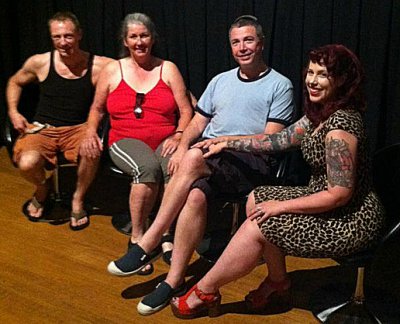
/nterviewees Jim Peterson, Betty Marshall,
Ernest Rhoads, Sarah Katherine Lewis |
Cathy
and I stay in touch through Facebook. And last year I went with Betty and
her boyfriend on a road trip to Canada to see a burlesque show featuring
another one of my actresses, Kitten Natividad. And I see Kitten when Iím
in Los Angeles.
But itís only this small handful that is still part of the entourage. And
that includes Ernie who appears in the documentary. And he appeared in
most of my post-Heart Attack Theatre projects,
including Fever (where he
played a battered lesbian serial killer named Toy.) You
don't appear on camera yourself in Heart
Attack! The Early Pulse Pounding Cinema of Kelly Hughes - why is
that then?
I
acted in school plays up through high school. But I always got a bigger
charge writing and directing. And have no need to be on camera. I
like doing voice-over narration. Itís actually the one thing Iím
professionally trained to do. And thatís where I show up the most in my
work. In Twin Cheeks
especially. I do the voice-over narration for the main character. I was
also a ďstunt handĒ in that. In a scene where I use tweezers to remove
a bit of paper under a corpseís fingernail (you only see me from the
wrist down). You can also see my hand in La
Cage aux Zombies ripping off a drag queenís wig (right after someone
has just ripped off her arm. Oh, the indignity of it all!)
I narrated the original version of my documentary Heart
Attack!, but decided to use title cards instead. You know, like
in a silent movie. And to mostly rely on the comments and recollections of
my actors. And to let the work speak for itself. I like to write about my
work (and am finishing up a memoir about it.) But talking about it in
voice-over felt cheesy to me. Maybe Iím just too self-conscious.
In
The Bicci Show, I have my one
Hitchcock-like cameo. I play one of the members at an Alcoholics Anonymous
meeting. I donít have any lines. But at one point I shake my head in
disgust while listening to the confessions of the main character. And then
I bow my head, and join the others as they recite The Serenity Prayer.
I did a singing cameo too. In Twin
Cheeks. We dubbed my voice in for the ďHanging By A ThreadĒ song
that the Homecoming Queen sings in a dream sequence. The actor, Bliss, who
played the Julee Cruise-inspired Homecoming Queen, originally sang it. And
did a good job. But for the final edit, I had to match the lyrics to
actual keyboard music that I played live while I sang and watched the
video of Bliss. Iím normally a bass. But for that song I sang falsetto.
Which added to the dream/nightmare quality. Oh, and I also dubbed in the
voice for one of the football players in the shower at the beginning of La
Cage aux Zombies. I recorded the actual actors. But the sound was so
echo-y and distorted against the hard tile-lined shower room walls. Plus
we had the showers on, and it drowned out the actors. So you can hear me
there too. And I sound really macho. J Some of your favourite Heart Attack
Theatre-movies? And how does it make you feel watching them from
today's point of view?
My
favorite episode is called Sisters.
And, like several other episodes, it is lost. I donít have a copy of it
anymore. Sisters is about a
psychic nun who uses her powers to help her identical twin sister who was
caught by her husband having an affair. They switch places. With the
cheating sister dressing like a nun and staying at the convent. And the
nun dressing like the sister and going to her home to erase the
husbandís memory. I liked the challenge of shooting one actress playing
both parts in the same scene, using a double for the back shots.
But
thereís many others I like for different reasons. One episode, Miserably,
was inspired by the movie Misery
(based on the Stephen King book.) One of my favorite scenes is when an
evil, but sexy nurse crushes a patientís knee with a hammer.
I
like another episode, Curse,
because itís the first one where Betty gets to carry an episode as the
lead. Sheís in almost every shot. And it has a gothic soap opera feel to
it. With our spooky effects mostly generated by the performances of Betty
and her co-star. It was very Dark
Shadows.
|
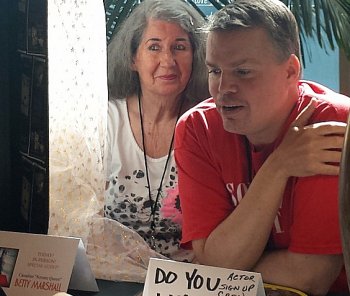
Betty Marshall and Kelly Hughes |
Watching
them now? Iím less self-conscious about the low budget video look of
them. When I made them, there was a certain amount of shame attached to
that. That it was all a half-step up from a home video camera. But the
funny thing is, with all the superb looking video out there, with all the
Hi-Def videos that even amateur filmmakers can put out now, Iím actually
more tolerant of the look of my old work.
Maybe
itís the new found appreciation for VHS home videotapes from the Ď80s
and Ď90s. The look and feel of something that came from the generation
before. Iím not sure. But Iím not embarrassed by the low budget look
anymore. I embrace it as it is. Even the glitches.
On La Cage aux Zombies,
you worked with cult actress Kitten Natividad - now you just have to talk
about working with her, and how did you get her even?
It
all started with John WatersÖ Back
in the early Ď80s, John Waters wrote a book called Shock Value.
And in it, he interviewed Russ Meyer. Kitten Natividad
was also part of that interview. Because she not only acted in his films,
but Kitten and Russ were also an item. And her bawdy remarks were the
parts that I remembered most from that interview. And that chapter in Shock ValueÖ
it must have planted a seed in my subconscious.
Because I would eventually have contact with all three of them. But in
ways I never could have dreamed or predicted.
I
think I talked to John Waters first. I read that he was going to do a
speaking engagement on the West Coast. So I used that as an excuse to call
the organizers of the event and request a press interview. We were in
different time zones. And when I called Waters to do the interview, I had
miscalculated the time difference between Seattle and Baltimore. And
called him an hour late. He was kind enough to reschedule. And when we
finally talked he was very gracious. He was also a tough nut to crack.
Only said what he wanted to say. But he was so witty and intelligent, I
kept the investigative journalism questions in check.
Russ
Meyer was a different story. He was visiting town for the Seattle Film
Festival. And I interviewed him at the Sheraton Hotel. In person. It was
right after I had worked with Kitten. And about ten minutes into the
interview, I mentioned that Kitten was going to be in a movie I was still
working on. And his mood shifted. He narrowed his eyes, looked straight at
me, and said something to the effect of: ďEverything Kittenís been
in--outside of my movies--has been total and utter shit.Ē
Perhaps
he still felt possessive of her. Or resented that I talked about anything
other than his career? I donít know. I was just trying to break the ice.
But his unyielding demeanor pushed a few of my own buttons. So I stopped
asking question. And we spent a full ten minutes just sitting there,
staring at each other. Seeing who would cave in to the awkward silence. I
canít remember who spoke first. But we eventually finished the
interview. And when we stepped out of the room, and joined the other PR
people working for the festival, Russ and I shook hands for photos, smiled
like old friends. Hell, he probably posed with his arm around my shoulder.
Who can remember now? And although Kitten eventually shared with me some
interesting anecdotes about their relationship, Iíve never pressed
Kitten for details. And to learn the full story, Iíll have to wait for
her autobiography like everyone else.
|
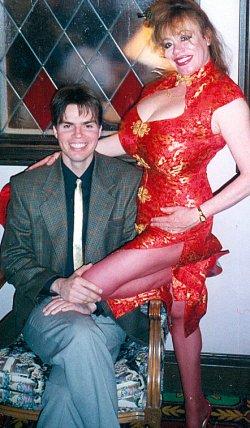
Kelly
with Kitten Natividad |
As
for working with KittenÖ I
first contacted her by sending her a letter. In the back of a magazine I
found an address for her fan club. A post office box. And I must have
written something enticing. Because she called me up a few weeks later,
and said she would like to be in La
Cage aux Zombies.
I
flew down to Los Angeles (using the little money and vacation time I had
back then. I was still working an office job to pay the bills). And we
filmed most of her scenes in front of her house. She lives near Paramount
Studios. And just recently I learned that her house is famous. Because the
writer Jack London used to live there. Kitten owns the building now. And
she rents it out and lives down the block from it. But during her
La Cage aux Zombies scenes, she did things that would make even Jack London
blush. Especially the scene where zombies drink milk from her breasts. Or
when her breasts get rolled up in a car window, and the moving car drags
her down the street. Or when she kills a zombie by smothering him in her
ample bosom. Oh well. Jack London might have blushed. But her neighbors
didnít. They barely gave us a second glance while we were shooting.
Also,
and this is somewhat heartbreaking to me, I made a documentary of Kitten during one of my trips down to L.A. (I think it was for a video
convention). I videotaped Kitten at her home during a pin-up style photo
shoot. I not only interviewed her throughout, but also tried to capture
the intimacy between Kitten and the photographer. They had quite a rapport
with each other. After I edited it, I had a screening of it here in
Seattle. But I never released it on home video. And Iíve been looking
for it for years. But canít find my copy. So I think it is lost forever.
Ironically, it has a listing on IMDb. So maybe thereís hope. Hereís
the link: http://www.imdb.com/title/tt4381936/?ref_=fn_al_tt_1
[Btw,
Waters also interviewed Herschell Gordon Lewis in Shock
Value. And recently I got the chance to interview Lewis myself. So I
guess I can cross that off my bucket list too.] How
did Heart Attack Theatre come to an end eventually? And can any of
the movies still be seen anywhere?
After
several seasons, I got burned out. But even though I stopped making new
episodes, the public access station still showed reruns of Heart Attack Theatre.
And often played episodes during gaps in the
programming when other people didnít turn their shows in.
A
Heart Attack Theatre
compilation was released on VHS home video in the late Ď90s. I chose
nine of my favorite episodes. Re-edited them. And created an entirely new
original soundtrack for it. You can still rent it at Scarecrow Video in
Seattle. And an occasional copy shows up on eBay. Although itís been
out-of-print for over fifteen years now.
There
will be a special DVD release, though. And it will also be in Scarecrow
Video. They are creating a new section devoted to shows that originated on
Seattle public access TV. And a new cover design is being created for it.
And it should be released within the next few months. Along with that,
Iím planning an online streaming release of it through VHX.TV. Thatís
the online streaming site where you can buy or rent the Heart
Attack! documentary
Thereís
also an upcoming documentary about Seattleís public access TV. Itís
called Channeling Yourself. And
they interviewed me for it. And will include clips from Heart Attack Theatre. So Iím excited about that.
I was also interviewed for another upcoming documentary called Blood on the Reels.
Itís directed and produced by Johnny Daggers,
a filmmaker from Pittsburgh who now lives and works in Baltimore. So he
understands both the George Romero and John Waters schools of filmmaking.
And is showcasing dozens of obscure horror directors in this documentary.
And giving them a platform to talk about their work. And expose their
movies to more people. Iím really excited to be included in it. The $64-question
though, where is Heart
Attack! The Early Pulse Pounding Cinema of Kelly Hughes available
from?
Hereís
a link to where you can buy it or rent it online as an instant streaming
download: http://heartattack.vhx.tv/
- I might eventually put it out on DVD. But for now, I like offering it
through VHX because it lets me keep the price down. And offers instant
gratification for viewers. J What can you tell us about your filmwork since
Heart
Attack Theatre?
I
did La Cage aux Zombies and Twin
Cheeks right after Heart Attack
Theatre. Then I moved out of Seattle for a while. And actually shot
some footage for a TV series called The
Trash Factory. It was about a low-budget movie company. And all these
crazy people who make these b-movies. And it featured some fun ďmovies
within the movieĒ footage. Which I filmed on Super 8 film. To contrast
with the video I was filming the main story on.
My
actor Bliss came up from L.A. to be in it. And we got some great footage
of him in some pretend horror movie scenes. They looked a bit like those
pretend trailers in Tarantinoís and Rodriguezís Grindhouse.
Maybe not as good as Eli Rothís Thanksgiving
trailer. I thought that was brilliant. But we had some pretty gritty
stuff. And the erratic and grainy Super 8 footage gave it a jerky,
unsettling quality.
Kitten
Natividad also appeared in a scene. She was in Canada for an event. And I
actually drove up there and picked her up, and brought her down to
Washington state for the shoot. Then drove her back to Canada the next day
so she could catch her plane back to L.A.
I
realized I would need more help and more resources to pull off a series
like The Trash Factory. I
couldnít do it as my usual crew-of-one. But it wasnít a total loss.
One of the characters played by Ernie sort of morphed into another
character. Which gave Ernie his first starring roles in one of my
projects. This was The Bicci Show. And Ernie got to play a bold and sassy interior
designer with an undercurrent of self-loathing. And a heavy dose of
self-destruction (such as taking a $20,000 advance for a design project,
and spending it all on drugs and prostitutes. Then finishing the project
with items from a thrift store).
I
shot it around 2001/2002, after Iíd moved back to Seattle. Betty was in
it. And we did things like crash a thrift store, and filmed Ernie
interacting with store workers. And then had them sign release forms
afterward. Which gave it a reality show feel, even though it was scripted.
It didnít have a horror element to it. But it was nice to explore some
new themes. And give Ernie another acting challenge.
Last
summer I did a short for the 48 Hour Film Project. Iíd been wanting to
try it because itís so similar to how I made Heart Attack
Theatre.
I lucked out and got the sci-fi genre. But did it more along the lines of
sci-fi/horror. And created a nasty little morsel called Green
State. You can watch it on my website. When I saw it on the big screen
with some of the other 48 Hour Film Project entries, I once again felt shame at how low
budget it looked compared to some of the other videos. (Was I still that
far behind on my video technology?) But at the same time, I was very
pleased at how I had held on to my aesthetic. And that out of all the
other entries, I thought I was the only one who achieved a sense of actual
sleaze. That todayís post-Tarantino filmmakers are very savvy and
boundary breaking. But that it still takes a special eye to put together a
film that makes you feel like youíre watching it at a drive-in theater
in 1973. Any future projects you'd like to
share?
Iíve
written a full-length script for a supernatural thriller called Lazy
Susan. Alison Arngrim wants to be in it. Sheís the actress who
played Nellie Oleson on Little House on the Prairie. Donít you think sheíd be great in a
horror movie? But I would have to make it a union production. You know,
SAG? And deal with all that paperwork and fundraising. Alison shot some
great interview footage for me to use in a crowd fund campaign for Lazy Susan.
And she did it with the other Hollywood actor I have
lined up for it, Jason Stuart. He and Alison are friends. And Iíve
really geared the script to take advantage of the rapport they naturally
have together. And their willingness to be really nasty characters. So
Iím gearing up to launch the crowd fund this year. And want to get the
proper funding to do it right. You canít do it half-assed when Nellie
Olesonís onboard. J
|
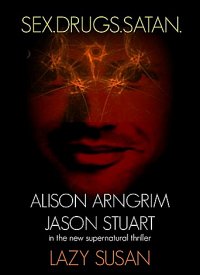
|
Iím
also finishing a novelization of La
Cage aux Zombies. Something Iíve been wanting to do for some time.
Not just to jump on the current zombie bandwagon. This is more of a
regurgitation. Using the movie as a starting point. But moving the story
into some new directions. Expanding the scope. And getting into the minds
of these characters that I really love. So it will have a fair amount of
humor and absurdity. How can it not with a title like that? How would you describe yourself as a director?
I
think I keep the action moving. I think I create tension in scenes. Iíve
always had to work fast. So I donít do a lot of takes like Kubrick.
Usual just one or two if I can. And I laugh a lot on-set. Itís probably
a combination of nerves and being entertained by my actors. And because
Iím always giddy, amazed that everyone is actually doing what I ask them
to.
Overall,
I think Iím focused on-set. Iím just really conditioned to get the
shots no matter what. To work around problems. To not give in to excuses.
To always be on schedule. To always get a little bit more intensity from
my actors. Filmmakers
who inspire you? Iíll
always admire John Waters. Because his movies were the first to really
mess with my mind. And itís interesting to see how he has evolved. And
how the mainstream has even caught up with him now. Brian De Palmaís
early films inspired me, especially Dressed To Kill. The first time I saw Jodorowskiís Holy
Mountain I thought, ďI donít know whatís going on, but I love
it. This is a work of art.Ē But now I really admire the unsung heroes of
made-for-TV movies. And the exploitation movie directors. The ones who may
not be household names. But have a solid work ethic. And cranked out those
little movie gems that keep showing up on late night television year
after year. And now, thankfully, online. It can be hard to stay motivated
when it feels like all the attention and acclaim is going to other
filmmakers. So Iím inspired by the ones who keep plugging away, even
when they arenít the flavor of the month. Iím also inspired by the
movie Criminally Insane (aka Crazy
Fat Ethel). Itís an example of how important casting is in a low
budget exploitation film. And how absolute conviction can transcend
quality. Making considerations such as ďCan these people act?Ē or
ďDoes this story make any sense?Ē irrelevant. This is a near perfect
movie. ...
and of course, films you really deplore?
I
donít want to offend anyone, but Iíve never liked the Star Wars movies. Even the early ďgoodĒ ones.
Iím more of a Star Trek person.
As
for movies I deploreÖ
I
hate ďacclaimedĒ movies that turn out to be clichťd and tedious. When
their acclaim comes from subject matter, not execution. I hate boring
movies with great posters that trick you into watching them. I hate movies
that were workshopped after winning a screenplay award at a film festival.
(And I hate myself for hating this because it probably means Iím jealous
and intolerant. But I have no patience for committees.) I hate most films
on Netflix. (But I really like a lot of their TV shows. Go figure.) I hate
it in movies when two gangsters point guns sideways at each other and have
a stand-off. I hate it when a character is given ďcharacterĒ by
smoking and drinking, especially when heís holding the drink in the same
hand as the cigarette. I hate when a filmmaker uses macho clichťs to
signal depth he hasnít established or worked up to.
 |
Feeling lucky?
Want to
search
any of my partnershops yourself
for more, better results?
(commissions earned) |
The links below
will take you
just there!!!
|
|
 |
A halfway good movie is always worse than a really bad movie, because a
really bad movie can have some lurid entertainment value. But the halfway
good movie makes you conscious of how it could have been better. And makes
you resent the filmmaker for missing the mark. Your/your
documentary's website, Facebook, whatever else?
Documentary
page: http://heartattack.vhx.tv
My
website: www.kellywaynehughes.com
Facebook
page: www.facebook.com/kelly.hughes.7758
Anyting
else you are dying to mention and I have merely forgotten to ask?
I
want to thank you for creating (re)Search
my Trash. And thank all the bloggers and podcasters who have saved me
and other underground filmmakers and our films from fading into obscurity.
For all the times we have been ignored by the mainstream media, being
recognized by a site like this totally makes up for it. And damn it, you
really know your movies here! Thanks
for the interview!
|